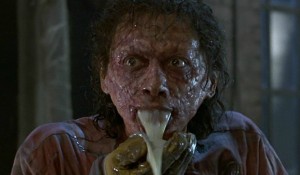I hate flies.
As a kid I would occupy myself for hours in my grandfather’s barn, swatting to death as many flies as I could. Sure it was futile, and a good indicator of life-long neuroses, but I sure like killing them.
 Many of the houses in Brisbane don’t have screens. We paid extra to have screens installed in our new townhome. But the neurotic cats have to hang out on the balcony so the screens sometimes stay open and flies swoop in to soil my lovingly prepared meals.
Many of the houses in Brisbane don’t have screens. We paid extra to have screens installed in our new townhome. But the neurotic cats have to hang out on the balcony so the screens sometimes stay open and flies swoop in to soil my lovingly prepared meals.
My daughter calls me Flyslayer.
My partner bought me this battery-charged, tennis-racquet sized flyswatter so I can zap flies mid-flight.
Here’s why:
The house fly, Musca domestica, has been implicated as a vector of Campylobacter spp., a major cause of human disease. Little is known whether house flies serve as biological amplifying hosts or mechanical vectors for  Campylobacter jejuni.
Campylobacter jejuni.
We investigated the period after C. jejuni had been ingested by house flies in which viable C. jejuni colonies could be isolated from whole bodies, the vomitus and the excreta of adult M. domestica and evaluated the activation of innate immune responses of house flies to ingested C. jejuni over time. C. jejuni could be cultured from infected houseflies soon after ingestion but no countable C. jejuni colonies were observed > 24 hours post-ingestion. We detected viable C. jejuni in house fly vomitus and excreta up to 4 hours after ingestion, but no viable bacteria were detected ≥ 8 hours. Suppression subtractive hybridization identified pathogen-induced gene expression in the intestinal tracts of adult house flies 4-24 hours after ingesting C. jejuni. We measured the expression of immune regulatory (thor, JNK, and spheroide) and effector (cecropin, diptericin, attacin, defensin and lysozyme) genes in C. jejuni-infected and -uninfected house flies using quantitative real time PCR. Some house fly factor, or combination of factors, eliminates C. jejuni within 24 hours post-ingestion.
Because C. jejuni is not amplified within the body of the housefly, this insect likely serves as a mechanical vector rather than as a true biological, amplifying vector for C. jejuni, and adds to our understanding of insect-pathogen interactions.
Campylobacter jejuni in Musca domestica: An examination of survival and transmission potential in light of the innate immune responses of the house flies
Insect Science. doi: 10.1111/1744-7917.12353.
Gill, S. Bahrndorff, and C. Lowenberger
